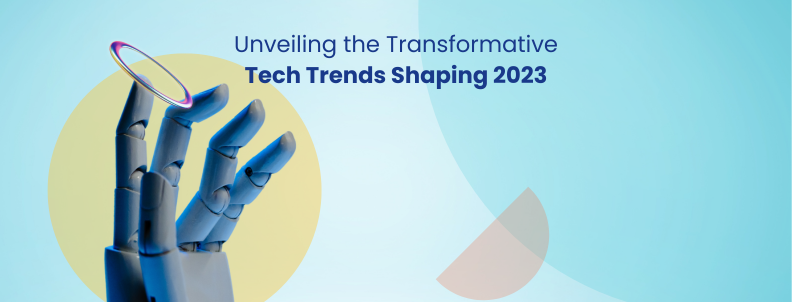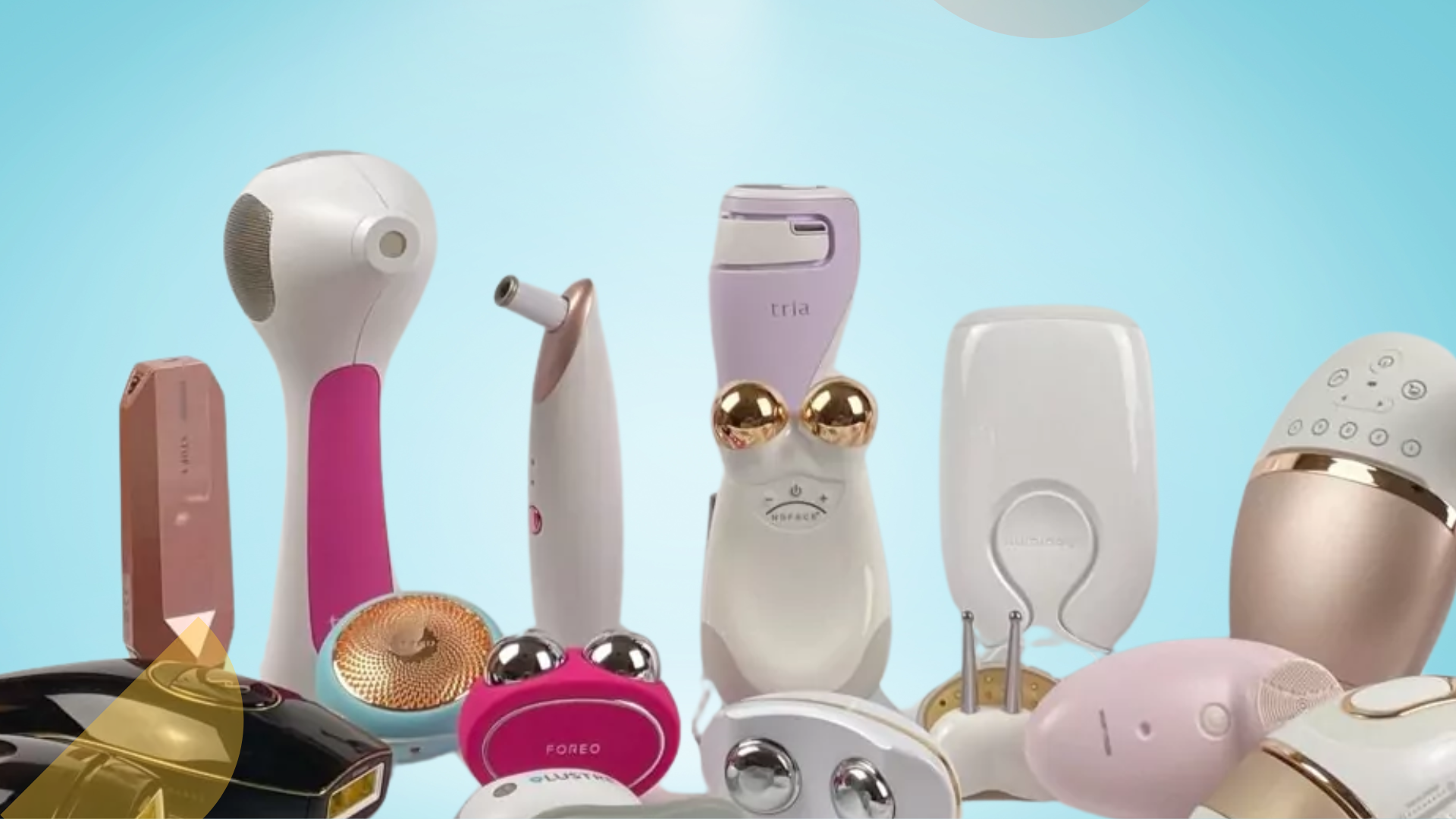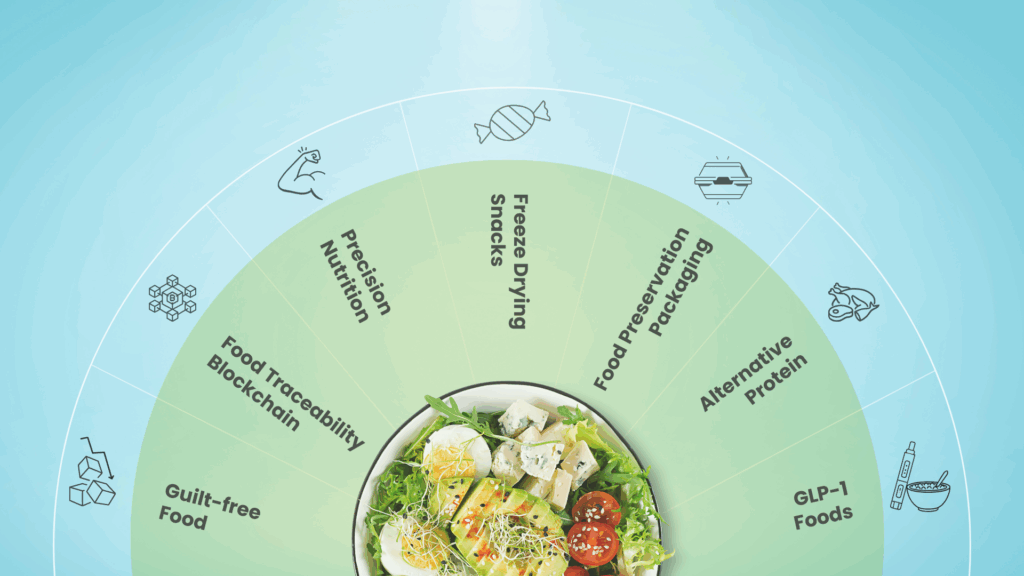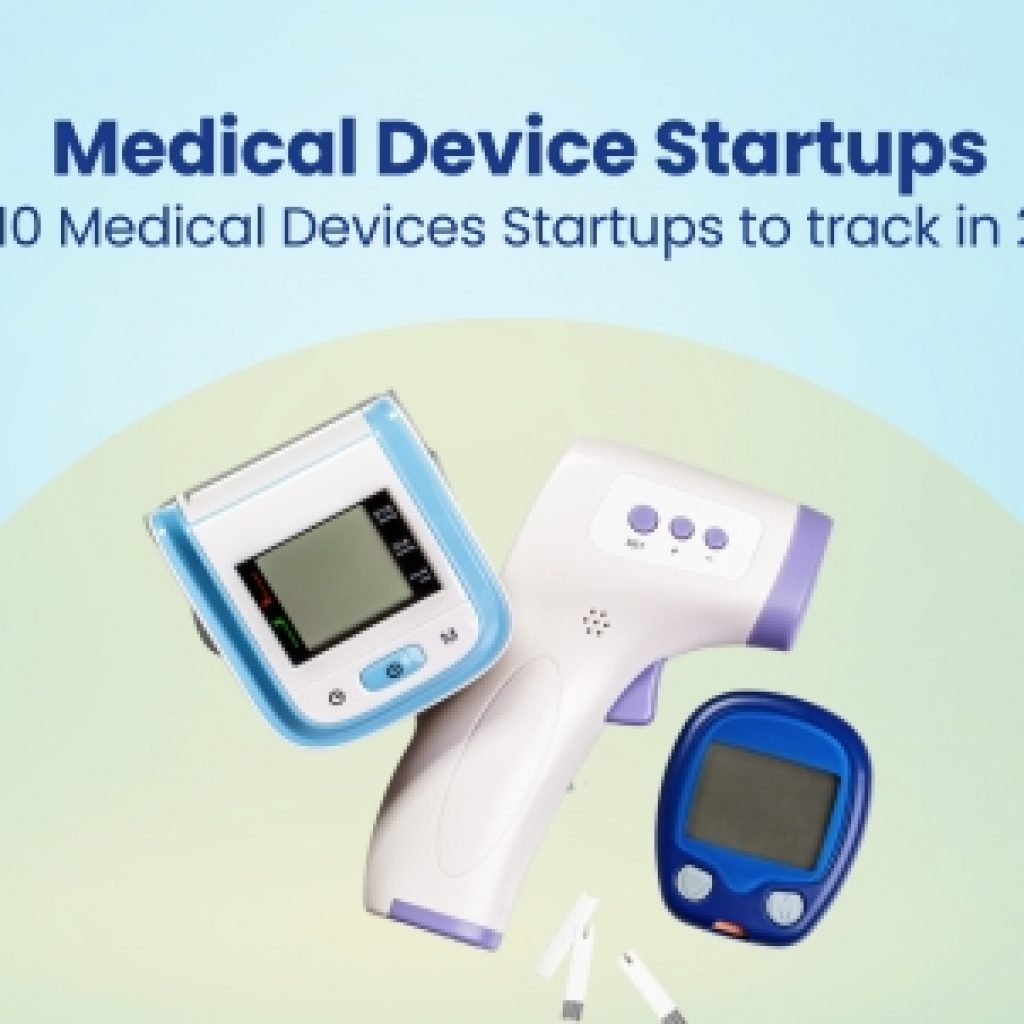“The future of innovation has to include not only technology but economic viability.”
– Dennis Muilenburg (CEO of Boeing)
The pace of technological change is accelerating rapidly, and with AI powering every industry, 2023 is set to be a pivotal year in this ongoing revolution. One of the most significant moves is the convergence of Industry 4.0 and sustainability.
As we look ahead to 2023, it’s clear that several key trends are set to shape the future of business and society.
From virtual power plants and green hydrogen changing how we use energy to AI and Metaverse solving critical industry problems with a network connection 100 times faster, these trends are poised to transform how we live, work, and interact with the world around us.
Waterless beauty products and lab-cultivated meat are just two examples. In this article, we will take a closer look at these emerging trends and explore the companies and innovations at the forefront embracing new technologies to drive long-term sustainability and efficiency across every industry.
1. Waterless Cosmetics – Zero-Water Beauty
“Waterless skincare is a game-changer. It’s not just better for the environment but also for your skin.”
– Marie Veronique, CEO of her eponymous brand
Beauty products formulated without water are augmenting in popularity. In addition, rising environmental awareness and interest in skincare have led to cosmetic formulations that use natural butter and oils to produce better-quality products.
The waterless cosmetic market was valued at $9.5 billion in 2021, and its growth forecast is exponential, to say the least. The expected CAGR is 12.2% from 2022 to 2029, merely due to the immense technological advancements and research in this area.
According to surveys conducted on the properties of waterless cosmetics, people also felt they were the better choice. This is because anhydrous products are typically more concentrated as they aren’t diluted by water. Therefore, they tend to work better and more quickly. Moreover, they are an excellent option for sensitive skin types as their products are not laced with synthetic preservatives to stop bacteria growth in water.
The price of going waterless, though, is slightly high for consumers due to the presence of more active ingredients. But according to reviews, the users feel that since the products may be used for a more extended period and provide good results, they would be willing to rebuy those products.
Now, let’s take a look at startups working in this sector.

Lifelong
Swedish startup launched in 2019 manufactures waterless products made with natural and safe ingredients free of mineral oil, paraben, and other chemicals. Their products must be kept overnight after being mixed in water for a consistent application. Lifelong also delivers its products in compostable paper packets that minimize waste production.
SuperZero
A company launched in 2019 aims to eliminate plastics, microplastics, and water in the hair and hand care products. Their anhydrous shampoos, conditioners, and hand balms lower their carbon footprint by 80-90% as they are created with plant-based ingredients. Soon, they aim to go a step further and take beauty to the next level.
Loli beauty
Launched in 2017, it is a US-based firm that manufactures superfood beauty products for the body that is waste, water, and toxins free. Amassed with a wide range of products to suit the diversified needs of the consumer, it has raised nearly 1.7 million in funding since its inception.
While startups are working on perfecting their waterless cosmetics, industry giants are working on grabbing the lion’s share of the market.
Will Unilever catch up with L’Oreal in waterless cosmetics?
L’Oreal is filing patents for powdered and waterless cosmetics. The company leads the race with five times more patents filed than its closest competitor – Unilever.
In addition, L’Oreal has committed to significantly decreasing its water usage by an impressive 60% per finished product unit. Similarly, Unilever aims to diminish the environmental impact of its product creation and utilization, including water consumption, by 50% by 2030.
One of L’OREAL’s recent patents is focused on formulating anhydrous sunscreen (rich in antioxidants) using carnauba wax that protects the formula from oxidation and avoids sensory degradation. Among various other steps, L’Oréal invested in the Swiss startup Gjosa in 2021, which is also L’Oreal’s R&D partner since 2015, to optimize shampoo rinse technology with minimal water consumption.
While waterless cosmetics is a significant trend in the industry, here are some other cosmetic industry trends you should know about.
Latest Beauty Devices Trends
Moving on to another ecological trend, cruelty-free meat.
2. Cruelty-free Lab-grown meat
“If we don’t create a science-based industrial agriculture revolution, we won’t be able to feed the world.”
– Avi Ben (Nestlé Israel CEO)
To produce 1kg of beef, around 1451 liters of water is used. In industrialized countries, the average person consumes 80 kilograms of meat annually. With meat consumption at an all-time high and expected to grow 50% by 2040, water will be scarce. This will likely exacerbate environmental problems.
This is where lab-cultured meat can be a viable option, as it offers an ecological solution without changing consumer eating habits.
Research shows that cultured beef may cause up to 92% less global warming and 93% less air pollution and use up to 95% less land and 78% less water than regular beef.
In addition, there are several other benefits of synthesized meat on the environment. For example, lab-grown meat does not require hormones or antibiotics, has fewer chances of contamination and spreading diseases, and eliminates livestock from the process. Due to such advantages, the industry is growing at a rapid rate.
The cultured meat market has a CAGR of 18.7% and is expected to reach $22.6 billion by 2032. Furthermore, according to research, its demand is expected to grow by 70% by 2050. Evidently, more than 100 startups are working on cultivated meat as of 2023, compared to only six companies in 2016. It has also attracted over $2 billion in funding from investors, and some startups have already made great strides in it.

SuperMeat
An Israeli company that aims to provide the world with clean and sustainable protein. It has raised around $3.2 million in investments since its inception in 2016. It also filed some patents regarding cultured meat in 2018 and 2022, respectively.
Good Meat
Other noteworthy patents for this technology have been filed by Good Meat in 2021, whose parent company is Just Eat. It is the first company in the world to sell cultivated meat, which is available in Singapore at select restaurants.
Other countries are also gearing up to follow Singapore soon. But, in all likelihood, Qatar will be the next one selling lab-produced meat commercially.
In the Americas, the FDA and the USDA jointly regulate cultured meat. USDA granted $10 million to create a center for cellular excellence and $1.5 million to Defined Bioscience to develop a cell culture medium supplement. Additionally, Israel was the first to open a ‘slaughter-free’ factory in the world in 2021, holding nearly a quarter of all investments in this sector. Israeli companies Future Meat and Aleph Farms have collectively raised $600 million, along with Super Meat.
Future Meat
The company has its own industrial cultured meat facility and produces cultured meat from fibroblast cells without additional serums or genetic modifications. It aims to create safe meat for the people and the environment while also being at par with the pricing of conventional meat. It plans to start sales in the US soon after obtaining the second funding round.
Aleph Farms
The company is focusing on producing beef steaks from cells to provide good nutrition to everyone in the world without any death of animals. Their products are made from 3D tissue formation technology that combines all vascular and connective tissues for an eating experience equivalent to standard meat.
But are lab-grown meats really cruelty-free? Our research suggests otherwise.
Now let’s see how the energy sector is moving towards industry 4.0.
3. Virtual Power Plants – Web of Decentralised Energy Sources
“Virtual power plants are a key technology for integrating renewable energy sources and ensuring grid stability and security.”
– Philipp Schröder, Chief Commercial Officer of Sonnen
Imagine a time when there were no power cuts or shortages. You probably can’t. Power is a renewable resource, but even then, its scarcity can sometimes be noted during peak demand periods. A virtual energy grid aims to solve that.
In theory, a Virtual Power Plant (VPP) is a network of distributed energy resources, medium-scale power-generating units, flexible power consumers, and storage systems that optimize energy usage. The VPP connects dispersed energy resources like wind farms, solar parks, and combined-heat-and-power units, enabling companies to observe, forecast, optimize, sell, and trade them.
In reality, Tesla’s VPP in South Australia aims to install solar panels and powerwall battery systems in over 50000 low-income houses to cut costs and build a more stabilized grid.
Being a steady power source with fewer electricity costs and infrequent power outages, VPP today has an estimated valuation of $0.88 billion and is expected to reach 6.47 billion by 2028. Moreover, its growing popularity has birthed several noteworthy innovations and collaborations as quite a few leading players in this market are working on finessing this service.
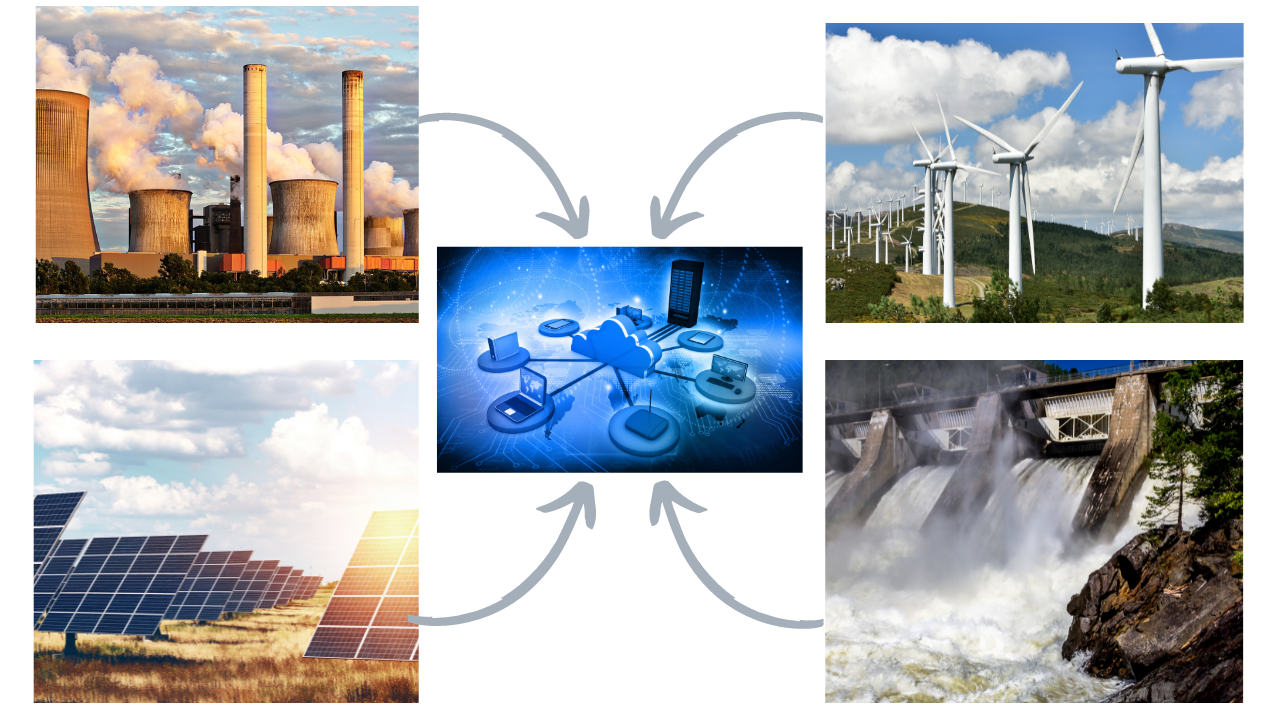
ABB’s power management solution
ABB, a leading Swedish-swiss multinational company, provides companies with Ability™ OPTIMAX®, a power management solution. It combines various energy resources and optimizes them into a virtual power plant. Which later can be bought or sold in wholesale energy market service. ABB, in collaboration with Hitachi, created a groundbreaking energy storage technology that has been selected for the construction of Singapore’s inaugural virtual power plant.
Additionally, Next Kraftwerke from Germany and Flexitricity from Edinburgh each manage fully flexible large-scale virtual power plants.
Next Kraftwerke
Next Kraftwerke’s VPP has 3,000 medium and small-scale power-producing units, which include but are not limited to biogas, wind, and solar generators. Its software also allows for easy management of power producers, consumers, and storage systems to provide diverse commercial opportunities. In addition, it has collaborated with Toshiba to start a service allowing third parties to create their virtual power plants.
Flexitricity
The company manages a 500MW virtual plant comprising consumers from around the United Kingdom, such as NHS hospitals, universities, local governments, district heating schemes, supermarkets, commercial farmers, etc.
Moreover, there are also a few startups that are making great strides in this trend.
Limejump
Limejump, another startup based in the United Kingdom, provides clean energy to homes and businesses by utilizing renewed and stored energy from wind turbines and solar panels. It was acquired by Shell Oil in the year 2019.
Naak, a California-based firm, integrates solar power, energy storage, load control, and energy automation for residential and commercial purposes. It empowers customers to actively participate in meeting their energy requirements.
This trend is seeing high demand in many parts of the world due to its numerous benefits, But it’s not the only solution for energy storage.
Here are five energy storage trends companies are working on this year.
4. Bio-based packaging – Environmentally sound packaging
“The future of packaging lies in biomaterials that can be composted, bio-digested or recycled, and in systems that allow the efficient recovery of resources.”
– Ellen MacArthur, the founder of the Ellen MacArthur Foundation
Nestle, the globally recognized food company, intends to ensure that all its packaging is reusable or recyclable by 2025. And it’s not the only one. Coca-cola is testing paper bottles for drinks, and Unilever plans on switching to biobased packaging for its laundry capsules.
It is clear as day that today’s companies are impactful of their plastic footprint and its dire environmental effects. Adding to it is the international pressure making them take significant measures to rectify it. No wonder the market size of bio-based packaging was around USD 452.7 billion in 2021 and is expected to touch 812.4 billion by 2030, with an anticipated CAGR of 6.71% within eight years till 2030.
Now, let’s look at some of the companies making major strides in making their packaging eco-friendly.

NatureWorks
Based out of Minneapolis, USA, NatureWorks produces a biopolymer called Ingeo, made from plants like corn and sugarcane. It creates various packaging materials, including films, rigid containers, and foam. It even has several patents related to its Ingeo biopolymer, including patents for producing biodegradable films and foam products.
Another company known for its food and beverage packaging made from paperboard and other materials is Tetra Pak.
Tetra Pak
Based in Switzerland, Tetra Pak has always been known for its top-shelf packaging. However, in recent years, it has been working on developing biobased packaging solutions, including using renewable materials and plant-based plastics.
Avantium
The Dutch company is developing a plant-based plastic called PEF (polyethylene furanoate) that can be used to create various packaging materials, including bottles and films. PEF is renewable, compostable, and has better barrier properties than traditional plastics. It also holds several patents on the production of the same.
Many other companies have also filed patents related to biobased packaging, including major consumer goods companies like Coca-Cola, Nestle, and Procter & Gamble. These patents cover various topics, including materials, packaging design, and production methods related to biodegradable packaging.
The field of biodegradable packaging is expansive and making explosive progress. But, it is only one of many methods for sustainable packaging.
To learn about another wave-making trend in the packaging industry, click here.
5. Green Hydrogen- The fuel of the future
“Green hydrogen is the oil of the future.”
– Patrick Pouyanné, CEO of Total
The International Energy Agency (IEA) estimates that there will be a 30-40% increase in non-renewable forms of energy, such as coal and oil, by 2040. Both of which are direct sources of air pollution and environmental problems. However, the legally binding Paris Agreement of 2016 ensures that countries take serious measures to reduce their carbon footprint. One of these measures was adopting green hydrogen as their primary energy source.
Green hydrogen is the only form of hydrogen that leaves no residue, emits no greenhouse gasses, and is entirely renewable among all its forms. It is versatile and produced through electrolysis, enabling water separation as vapor. While mass production of green hydrogen is expensive, the World Hydrogen Council predicts its production costs will fall by 50% by 2030.
Due to its rise in popularity as a clean energy source and estimated lowered production costs, its expected CAGR is a whopping 55.2% till 2028, with a market value of $10.2 Billion. As a result, several notable companies have made considerable investments in the advancements in this field.

KEYOU
KEYOU is a German hydrogen technology company that converts conventional diesel engines into zero-emission hydrogen engines. The process combines efficient injection, exhaust gas recirculation, turbocharging, and a patented hydrogen catalytic converter.
H2Pro
The company has developed a new way to split hydrogen from oxygen that is 25% more efficient than electrolysis. Moreover, they are well-suited to high-pressure hydrogen production and cost-effective scalability.
There have also been other innovations to separate hydrogen from water. For example, the finalists of the European patent awards 2022, Johan Martens and his two graduate students, have developed a solar panel capable of extracting green hydrogen directly from the air with the help of sunlight.
With so many exciting advancements happening in this field, you must think there’s no way this is the complete list. Well, you are right. For the comprehensive report, click here.
6. Biotechnology in digital healthcare: A rising revolution
“Biotechnology is revolutionizing medicine and transforming the way we treat diseases.”
– Susan Desmond-Hellmann, former CEO of the Bill and Melinda Gates Foundation
The field of biotechnology is constantly evolving in the field of healthcare. It has played a significant role in developing vaccines and treatments for cancer, HIV/AIDS, and COVID-19.
Not only that, but it is also being used to produce therapeutic proteins, such as insulin, growth hormone, clotting factors, monoclonal antibodies, gene therapy, diagnostic tests, and tissue engineering techniques.
Biotechnology has the potential to solve significant problems in the health sector. It had a market value of USD 753.48 billion in 2020 and is expected to grow at a CAGR of 15.5% during the forecast period (2021-2027).
Now, let’s look at some companies investing in biotechnology to create products that can target various problems of the human body.

Amgen
A biotechnology company based out of Thousand Oaks, California, develops and markets therapies for various diseases, including cancer, cardiovascular disease, and autoimmune disorders.
With over 25000 patents filed globally, they reach into advanced gene analysis and create products targeting specific conditions.
Moderna
The Cambridge-based biotechnology company is developing messenger RNA (mRNA) therapeutics and vaccines. Moreover, the COVID-19 vaccine they developed was among the earliest to be granted emergency use authorization by the FDA.
Gilead Sciences
Another example of healthcare companies investing in biotechnology is Gilead Sciences from California. It develops therapies for HIV/AIDS, liver disease, and cancer. Their products include Sovaldi, a treatment for hepatitis C, and Remdesivir, a drug used to treat COVID-19.
Regeneron
The company has developed therapies for various diseases, including cancer, eye, and inflammatory conditions. Its products include Eylea, a treatment for age-related macular degeneration, and Dupixent, a treatment for atopic dermatitis.
That was it for known companies working with biotechnology in healthcare. Want to know about the startups working on it? Click here.
7. AI- Augmenting intelligence and efficiency
“AI will be the defining technology of our time, just as the steam engine was for the Industrial Revolution.”
– Satya Nadella, CEO of Microsoft
Voice assistants, face unlock sensors and disease detection, the uses of AI are limitless. There are tons of AI-based applications out there that have changed the way we work. From AI writing and sounding like humans to voice-controlled devices that can pander to most whims of a user, there has been tremendous progress in how AI functions.
It has brought the world closer. The dramatic rise of AI-based platforms, tools, and applications since 2018 is bridging the consumer gap, as numerous patents are filed yearly.

It is one of the top three companies that filed the most patents in AI. Google’s commitment to AI research and development is evident in its various initiatives, programs, and partnerships. Their research and development teams are exploring state-of-the-art technologies such as machine learning, natural language processing, computer vision, and robotics, to name a few. It has even collaborated with the Mayo Clinic to revolutionize how healthcare is delivered and increase the speed of healthcare innovation.
Microsoft
Next in line is Microsoft. With the second spot on the list of most patents filed on AI, it assists researchers, non-profits, and organizations that use technology and artificial intelligence to impact various fields positively. In addition, its AI can potentially democratize artificial intelligence’s use, development, and innovation in meaningful and relevant ways. For example, the technology enables new applications across Microsoft 365 to help users improve their writing and creation abilities, display maps and charts in Excel, and simplify email management.
Its project Bonsai is a machine learning, improvement, and measurement system that will revolutionize industrial machinery. It will offer autonomy to control machinery at the heart of any equipment (pretty cool, right?).
Now, let’s talk about the company that holds the most number of patents in AI, with the number standing at a prodigious 3007. Yes, you guessed it right, it’s IBM!
IBM
With its fingers in all sorts of pies, IBM is working on a service, among others, that will shift from detecting frauds to protecting from them. Soon, its AI will be able to see if fraud occurs during a transaction, a very welcome necessity in the virtual world riddled with people coming up with new ways to steal online.
Considering all the innovations in this field, there’s no doubt that artificial intelligence will soon be present in everything we see, and hence its value will rise. In 2022 itself, the industry was valued at US $119.78 billion. Since it is so omniscient already, it is entirely believable that it is expected to have a market value of US $1591.03 billion by 2030, with a CAGR of 38.1% from 2022-2030. A value that by any means isn’t a small feat.
That’s not to say that the contributions of startups can be overlooked. For example, ChatGpt by OpenAI is perhaps the most talked about AI invention recently. From writing poetry to finding and conversationally explaining information, it is admirable, to say the least. It provides direct answers, and for people who prefer that instead of scrolling to find the perfect one, ChatGpt is indeed a worthy adversary to search engines. And since it is a self-learning AI model, it spouts more relevant and valuable information daily.
These are only the top handful of companies making waves in AI. However, here’s a list of 10 AI companies leading the research.
Now let’s look at some of the trends on the horizon this year.
8. The Future of Computing: A Quantum Leap Forward
“Quantum computing represents a new paradigm in computing that will enable us to tackle problems that are currently unsolvable.”
– Michelle Simmons, Director of CQC2T
Quantum computers are not yet readily available for commercial use. They are still nascent, but companies like IBM, Google, and Microsoft invest significantly in quantum computing research and development.
This is mainly because they have the potential to revolutionize various industries and lead to breakthroughs in fields like finance, medicine, and artificial intelligence.
This speed and power of quantum computing have already led to exciting advancements, such as developing new drugs, optimizing supply chains, and advancing cryptography.
Therefore, it’s no wonder that its expected CAGR is 38.3%, with its current valuation at $866 million and expected valuation of USD 4375 million by 2028. Of course, as research continues, we can expect to see even more transformative applications of quantum computing in the near future, but for now, let’s see the companies already working on it.

IBM
Qiskit, a full-stack quantum software by IBM, makes quantum programming accessible to academics, educators, developers, and enthusiasts. It can identify mistakes, autocomplete code, and visualize complicated quantum states. IBM has furthermore collaborated with IIT Madras to provide quantum computing education to encourage research in the field.
In terms of startups, 1Qbit, based out of Canada, is focused on harnessing the power of quantum physics to assist advanced computing software. It also has a granted patent to its name.
While a startup named, IonQ from Maryland, USA, has 19 patents to its name in the same field. It builds quantum computing through ionized ytterbium atoms, a naturally occurring earth metal that can remain stable for a long time when prepared in a specific quantum state.
IQbit, IonQ, Microsoft, and Honeywell have provided hardware to Microsoft to create Azure Quantum. Azure Quantum provides most quantum services under one roof but is only available to a select few for the moment.
But that’s not it. There is so much more to know about startups in Quantum computing.
9. Robots in the house – Transforming homes into intelligent, connected ecosystems.
“The future of household appliances is AI-driven, with smart features that make them more intuitive and user-friendly.”
– Rajat Monga, Engineering Director at Google Brain
Since Amazon acquired the manufacturer of Roomba, iRobot, there has been speculation about a Roomba that can be controlled with voice commands. The company has even filed a patent for the same.
In comparison, Google has filed a patent for “multi-user personalization” to recognize the person talking to it. This technology will be able to “authenticate an occupant and present a response, or restrict the functionality of the electronic device.”
That’s not all. Google also aims to become better at AI-people conversations through its smart home devices. For example, a seamless ‘hmm’ during a long rant to show that Google is still listening will go a long way in home robots.
When integrating emotional responses in-home devices, Amazon wants to know the user’s emotional mood to tailor its response. Examples can include suggesting mood-appropriate movies, comfort food, etc. The catch is that it aims to do this by analyzing the tone of the speaker’s voice and not direct voice commands.
As far as innovations go, this may not seem like one that has all its ducks in a row for the moment, but seeing the pace of technology, we can very likely see this tech materialize soon.
The expected growth of robots in homes is USD 30.7 billion by 2030, with a CAGR of 20.7% in the forecast period (2022-2030).

Robomow
A famous home robot that is contributing to this market value is Robomow. It is available in different variants that can charge independently and mow regularly without additional commands. But, if a consumer wants to give it commands, It also supports a feature that allows it to be integrated with Alexa.
SMP Robotics
Another famous tech for house robots is home surveillance robots. After mapping it, such robots can patrol within a house and send back videos of what they have captured. S5 PTZ Security Patrol robot is one option that can even make siren noises to scare off wild animals.
Now, let’s talk about the most important house chore, cleaning: the primary reason people invest in home robots.
Trifo
The startup is headquartered in Santa Clara, California, with 50 patents filed in US and China. It cleans and is equipped with 1080P HD, depth cameras, and advanced ToF sensors for protection against home intruders and pet surveillance. In addition, it has a live feed and can even capture videos in the dark. But, of course, there’s no need to worry about pets, as it has a built-in microphone and speaker to communicate with pets. (How cool is that?)
We have a market saturated with robots that clean, but do we have a robot that can pick up toys and deposit them into their assigned bins? Well, soon we will!
Clutterbot
The New Zealand-based startup is developing a small-sized robot that will be a boon to parents everywhere as it can pick up small toys and drop them into their assigned bins. It also has filed a patent for the same and hopes to launch its technology out in the world soon.
While the industry is still nascent, it will be interesting to see how it grows in the future.
Our next trend read is an (in)famous one. Care to guess which is it?
10. Metaverse – A Convergence of Physical and Virtual Reality
“The metaverse is the next generation of the internet, where we will be able to interact with a virtual world in a way that feels completely natural.”
Tim Sweeney, CEO of Epic Games
As soon as this technology emerged, Meta emerged with big ambitions and acquired Oculus for $2 billion. The Recent reports, however, suggest that the metaverse envisioned by Mark Zuckerberg is failing. But wouldn’t it be hasty to deem the entire concept of blending physical and virtual reality flawed?
Even though the world is apprehensive of Meta’s vision, Mark Zuckerberg says, “Building the metaverse is a long-term project, but the rationale for it remains the same, and we remain committed to it.”
Technology has continually advanced by creating more immersive and interactive experiences, and it is reasonable to anticipate a world similar to the metaverse in the future. Whether Zuckerberg or another entity develops it, and whether it is named the Metaverse, is a possibility that remains uncertain.

Evidently, this year, the mammoth company of Lego, famous worldwide, has filed a patent to venture into the metaverse. It aims to build a virtual reality synonymous with the toy, like a virtual farm for someone seeking to build a tractor. Source
This is just one example. The metaverse is becoming a concrete reality as it seeps into all domains of life. Let’s start by taking a look at how it’s transforming the healthcare sector.
8Chilli
Its metaverse platform, HintVR, provides immersive support during pre- and post-operation and training for a medical procedure. They have applied for a patent for the same. It is based on a technology that utilizes two sets of cameras to enable an AR device to simulate a 3D environment by providing depth and visual perceptions.
AnyMedi
AnyMedi is a South Korea-based start-up in the MedTech domain that aims to eliminate uncertainty in medical procedures. They offer patented technological solutions for surgical planning and implant manufacturing, including 3D modeling to personalize medical solutions for each patient.
AnyMedi uses AR-VR and robotics to offer MedTech solutions in implants, surgical guides, and simulators and has 27 patented innovations in the field. They focus on precision medicine that analyzes patients’ genomic and clinical information to provide tailored medical services.
Metaverse has had a significant impact not only on the medical field but also on the fashion industry.
Spacerunners, based out of the Greater Houston Area, Southern US, have created the first fashion metaverse – Spaceverse, bringing together community, brands, and celebrities.
Due to its adoption in various sectors, Metaverse was estimated at a valuation of USD 61.8 Billion in 2022. This value is not just expected to double or treble but becomes seven times its worth at USD 426.2 Billion in merely five years (2027).
Other start-ups, like Polkawar, NextMeet, Zash, and Playersonly, contribute to making a metaverse that will blow minds (metaphorically, of course).
Nextmeet, for example, enables people to hold meetings, collaborate on projects, and do much more in a 3D setting.
At the same time, Polkawar is a gaming platform that is taking trading in gaming merchandise to another level by earning cryptocurrency for their NFTs.
Interested in knowing about other application areas Metaverse is making a mark on? Check out our detailed study on the applications of the Metaverse!
Conclusion
The above technologies are evolving with leaps and bounds. Some trends might be more present in the now. But according to GreyB’s expertise in information research, it can be said that these trends will most likely gain a lot of momentum in the coming year.
Want to know more about the upcoming trends from a specific industry and the companies working on them?
Let us know in the comment section.
Authored By: Moksha Jain, Marketing Team.

